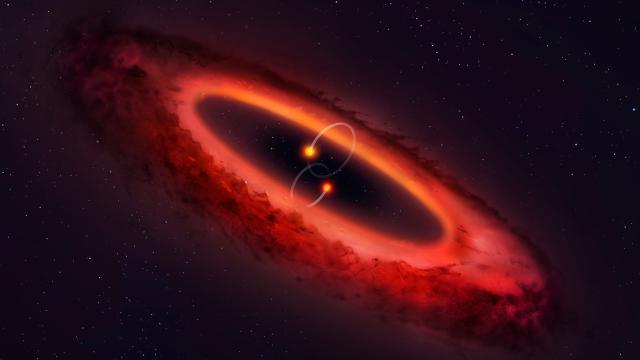Astronomers using the ALMA telescope have discovered an oddly tilted planet-forming disk within a double binary star system, a configuration that up until this point only existed in theory.
Quadruple star systems featuring two binary pairs are a surrounding protoplanetary disk – a ring of gas and dust that gradually congeals to form planets.
A star system located 146 light-years from Earth, called HD 98800, has all these things, but as new research published today in Nature Astronomy reveals, this system features an exceptionally strange protoplanetary disk.
HD 98800 features an inner binary pair of stars and an outer pair. The pair on the inside, called BaBb, are in close proximity to each other, around 1 AU, which is the average distance from the Earth to the Sun. Its outer pair, called AaAb, is much further out at 54 AU — a much greater distance than the stretch between Pluto and the Sun (40 AU). But never mind the outer pair—it’s the inner pair and its surrounding disk that’s interesting.
Normally, a protoplanetary disk rests along the same plane as the orbital plane of its binary star hosts. But not HD 98800—its protoplanetary disk rests perpendicularly to the plane of the binary pair at a right angle. It’s in a polar configuration, where instead of running east-west, the disk is running north-south, so to speak.
Here’s another analogy: The inner binary pair are like two horses going around on a carousel, while the protoplanetary disk is like a giant ferris wheel with the carousel at its center.
Prior to this finding, systems such as HD 98800 only existed in theory.
“Disks rich in gas and dust are seen around nearly all young stars, and we know that at least a third of the ones orbiting single stars form planets,” Grant Kennedy, an astronomer at the University of Warwick and the lead author of the new study, said in a statement.
“Some of these planets end up being misaligned with the spin of the star, so we’ve been wondering whether a similar thing might be possible for circumbinary planets. A quirk of the dynamics means that a so-called polar misalignment should be possible, but until now we had no evidence of misaligned disks in which these planets might form.”
Astronomers have known about HD 98800 for several years. Previously, scientists had tracked the motions of its inner stars to see how they moved in relation to each other. Now, using the Atacama Large Millimetre/submillimeter Array (ALMA), Kennedy’s team was able to visually inspect the system and characterise the orientation of the protoplanetary ring surrounding the inner binary pair.
Fascinatingly, and despite this odd configuration, HD 98800 still exhibits characteristics consistent with early planetary formation.
“We take this to mean planet formation can at least get started in these polar circumbinary disks,” explained Kennedy. “If the rest of the planet formation process can happen, there might be a whole population of misaligned circumbinary planets that we have yet to discover, and things like weird seasonal variations to consider.”
But while planetary formation can get started, it’s not clear the degree to which planets can form and remain stable within such a seemingly chaotic system. Should planets or planetesimals exist, however, the view from one an object within such a system would be extraordinary. Standing on one of these planetesimals, you would see the arc of the protoplanetary disk extending out from the horizon, reaching directly overhead, and returning to the horizon behind you. Meanwhile, at a spot along the disk, two stars would be seen looping back and forth around the protoplanetary disk.
“This is a very exciting result,” Konstantin Batygin, an astronomer at Caltech who’s not affiliated with the new research, told Gizmodo. “Configurations of this type are exactly what one would expect from the interplay between gravity and internal dissipation within protoplanetary disks. The discovery of the first such system suggests that the modelling efforts were essentially spot-on. Without a doubt, more such systems will be discovered in the future.”
Daniel Tamayo, an astronomer at Princeton, also not involved with the new study, agreed, describing it as a “fantastic paper” with an “unambiguous and beautiful discovery.”
“It’s a funny mathematical quirk of orbital dynamics that polar orbits around a binary star system are a very stable configuration, but it wasn’t clear whether nature would ever form them there in the first place,” Tamayo told Gizmodo. “There have been several previous examples of highly inclined disks, but this is the first slam-dunk case, and a real testament to the authors’ careful work and the new ALMA observatory’s fantastic technical capabilities.”
The next challenge will be for astronomers to identify similar systems, and at different stages in their development. The discovery of actual planets within such as system would be particularly mind-blowing.
